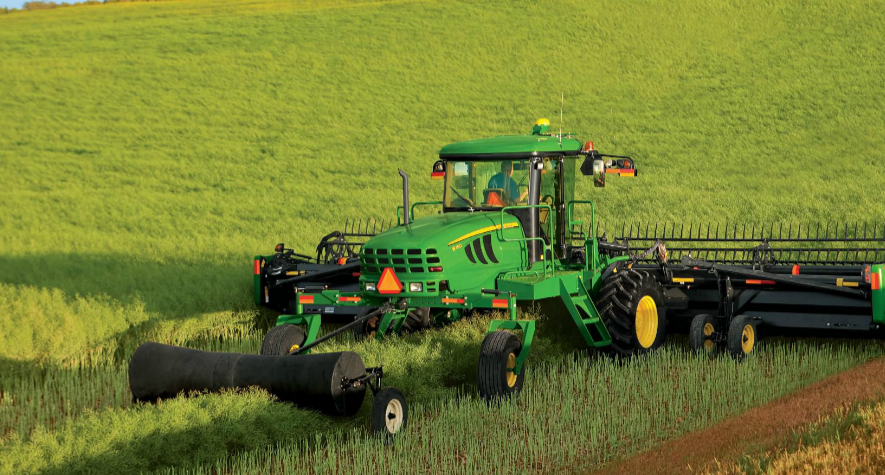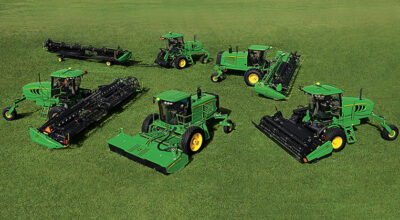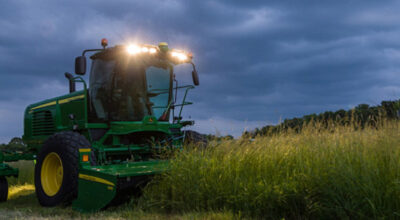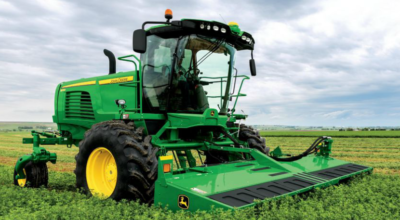We believe that productivity is the underlying key to success in the farming industry. When making hay, windrowers act as an essential tool to ensure you not only grow an excellent product, but that it’s done efficiently and with optimal productivity.
Haymaking is tough, tiresome, and time-consuming, but it’s a necessary task for farmers with animals to feed. When the time comes to cut and bale hay, make sure you have the right self-propelled windrower in place to lessen the burden of the task and improve overall productivity.
7 Productivity Tips for Your Self-Propelled Windrower
Consider these techniques, attachments, and tips the next time you take your John Deere self-propelled windrower out into the hay field.
Tip 1. Check Your Perimeter First
Before you begin cutting your hay crop, be sure to do a scan of the field perimeter to check for branches, sticks, and other debris that could harm your
self-propelled windrower. If a foreign object gets caught in your windrower, its teeth can break and prevent you from getting the job done well or at all.
Tip 2. Make Use of Xenon Halogen Lights
If you spent your day occupied by another commitment, you may have missed the window of daylight for cutting hay. By attaching halogen lights to the cab of your self-propelled windrower, you have the option to work after dark.
Tip 3. Bolster Your Windrower with the Reel Spider Reinforcement Kit
Even the strongest parts suffer wear from tough conditions and long days of work. By investing in the Deere Reel Spider Reinforcement Kit, you can ensure the lasting life of your reel spider with this reinforcement strap to minimize potential damage that could prevent you from completing your haymaking tasks.
Tip 4. Don’t Delay Scheduling Part Replacement
The blades of your self-propelled windrower will dull over time and their ability to cleanly cut hay will decrease. Hay that is cut with a dull blade can tear and dry out more quickly; it also leaves the remaining hay stubble vulnerable to disease.
Tip 5. Keep on Top of Operation Monitoring
It’s essential that you keep a close eye on gauges, dials, and other machine indicators. Ignoring alerts from these monitors can lead to preventable damage to your self-propelled windrower; the same is true with any piece of farm equipment.
Tip 6. Don’t Put Off Trouble-Shooting
If you notice a problem with your self-propelled windrower, it’s important to perform a full diagnosis of the machine to figure out where the root of the issue is. Once you find the source, you can repair the problem or have an expert take a look.
Tip 7. Keep a Steady Speed
Although driving fast might seem like an obvious way to ramp up productivity, it can be detrimental to the state of hay stubble. Maintain an even speed across the field, especially if the conditions aren’t ideal, to ensure a smooth cut to every blade of hay. It’s better to do it right the first time than have to do it again or suffer the consequences of a poorly done job.
We believe a productive farmer is a successful farmer. But without reliable equipment and techniques productivity suffers and, subsequently, so does business.
Commonly-Asked Questions About Self-Propelled Windrowers
What is a Self-Propelled Windrower?
A self-propelled windrower is an agricultural machine that cuts hay or small grain crops and lays them in rows called windrows in preparation for later threshing or cleaning. While there are multiple types of windrowers, a self-propelled windrower, as its name suggests, does its work under its own power and does not need to be pulled by a tractor.
Is a Swather the Same as a Windrower?
In general, “swather” and “windrower” are two different terms for the same piece of farm machinery, used for cutting hay and small grain crops and laying them in rows called windrows. In North America, these machines are generally known as “swathers”, while in Australia and other parts of the world, they are known as “windrowers”.
Is a Windrower a Tractor?
A windrower is not the same thing as a tractor. While they are both pieces of farm machinery, a tractor generally has many uses and is always self-propelled, while a windrower generally performs only its primary function and may be either self-propelled or drawn by a tractor.
To learn more about your self-propelled windrower and other John Deere equipment, contact your local John Deere dealer.
If you enjoyed this post or want to read others, feel free to connect with us on Facebook, Pinterest, Twitter, or Instagram!




